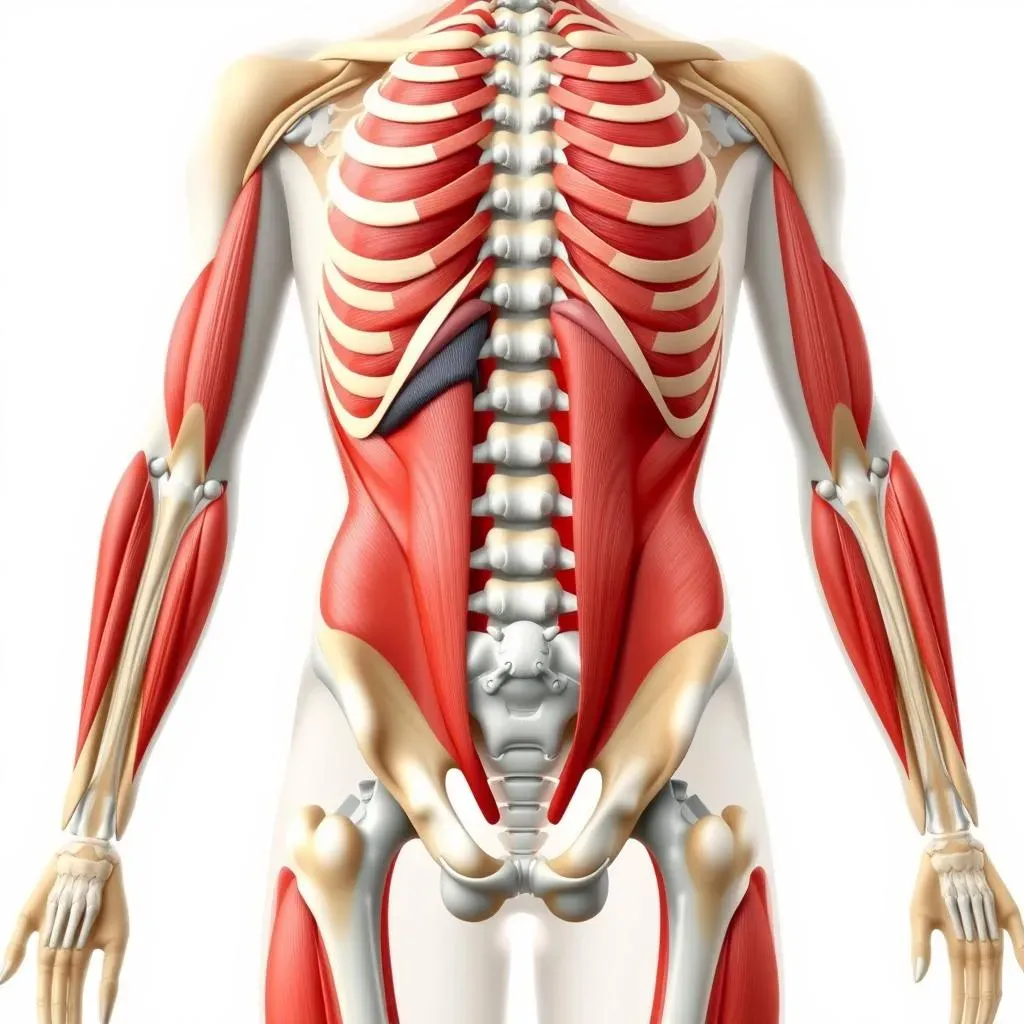Table of Contents
Want a stronger core than ever before? Forget endless crunches. Kettlebell workouts for core strength are a game-changer. They offer a unique challenge, lighting up muscles you didn't even know you had. This isn't just about six-pack abs; it's about building a powerhouse that improves your posture, stability, and overall fitness. In this guide, we'll dive deep into the world of kettlebell core training. First, you'll learn about the anatomy of your core and why kettlebells are so effective. Next, we'll break down specific exercises. From the Turkish get-up to the single-arm swing, you'll discover how to target every part of your midsection. Also, we'll provide sample circuits to integrate these movements into your routine. Finally, we'll discuss how to progressively overload your core for maximum growth and strength gains. Get ready to unlock a new level of core power with kettlebell workouts for core strength.
Understanding Your Core: Anatomy and Function

Understanding Your Core: Anatomy and Function
So, you want to understand your core? It's way more than just your "abs." Think of your core as the central support system for your entire body. It's a complex network of muscles that work together to stabilize your spine, transfer power, and allow you to move efficiently. When people talk about "the core," they often picture the rectus abdominis, which is responsible for that coveted six-pack look. However, that's only one piece of the puzzle.
The core also includes the obliques (internal and external), running along the sides of your torso, enabling twisting and bending motions. Then there's the transverse abdominis, the deepest layer of abdominal muscle, acting like a natural weightlifting belt by compressing your abdomen and supporting your spine. Finally, don't forget the muscles of your lower back, like the erector spinae, which are crucial for maintaining posture and preventing back pain. All these muscles work together to provide stability and control.
Understanding how these muscles function together is key to effective core training. It's not just about doing a bunch of sit-ups. It's about training your core to resist unwanted movement, stabilize your spine, and transfer force efficiently. That's where kettlebells come in.
Kettlebell Exercises for Core Strength: A Detailed Look

Kettlebell Exercises for Core Strength: A Detailed Look
Kettlebell Swings: The King of Core
The kettlebell swing isn't just a great cardio exercise. It's a phenomenal core builder. The dynamic nature of the swing forces your core to constantly stabilize your spine against the forward momentum of the kettlebell. This engages your entire core, from your abs and obliques to your lower back. Focus on hinging at the hips, keeping your back straight, and squeezing your glutes at the top of the swing. Think of it as a powerful plank with movement.
Proper form is crucial to avoid injury and maximize core engagement. Start with a lighter kettlebell and gradually increase the weight as your form improves. Remember, the power comes from your hips, not your arms. Your arms should simply guide the kettlebell.
Turkish Get-Up: A Full-Body Core Challenge
The Turkish get-up is a complex, multi-step exercise that challenges your core stability, strength, and coordination. It involves moving from a lying position to a standing position while holding a kettlebell overhead. Each step of the get-up requires your core to stabilize your spine and prevent unwanted movement. This exercise targets every muscle in your core, as well as your shoulders, legs, and glutes.
Start with a light kettlebell or even just your shoe to master the movement pattern. Break the exercise down into smaller steps and focus on maintaining a straight line from your wrist to your shoulder throughout the entire movement. The Turkish get-up is a true test of core strength and stability.
Kettlebell Dead Bug Pullover: 360-Degree Core Activation
The kettlebell dead bug pullover is an awesome exercise for hitting your core from all angles. Lie on your back with your knees bent and feet off the ground, holding a kettlebell straight above your chest. Now, while keeping your lower back pressed into the floor, slowly extend your arms overhead, lowering the kettlebell towards the ground. At the same time, extend one leg straight out, keeping it off the floor.
This exercise challenges your core to resist extension and rotation, working your abs, obliques, back, chest, and shoulders. It’s like a plank, but on your back, with added movement and resistance. Start with a light kettlebell and focus on maintaining a stable core throughout the exercise. If you feel any pain in your lower back, reduce the range of motion or use a lighter weight.
Sample Kettlebell Workouts for Core Strength: Circuits and Progressions

Sample Kettlebell Workouts for Core Strength: Circuits and Progressions
Beginner Kettlebell Core Circuit
Ready to put those kettlebell exercises into action? This beginner circuit is perfect for building a solid core foundation. Perform each exercise for the prescribed number of reps, then move on to the next with minimal rest. After completing all exercises, rest for 1-2 minutes and repeat the circuit 2-3 times. Remember to focus on proper form over speed.
This circuit includes movements like Kettlebell Swings (10 reps), Turkish Get-Ups (1 rep per side), Kettlebell Dead Bug Pullovers (8 reps per side), and Plank with Kettlebell Drag (30 seconds). As you get stronger, you can increase the number of reps, sets, or the weight of the kettlebell. The point is to start slow and build gradually.
Exercise | Reps/Time | Sets | Rest |
|---|---|---|---|
Kettlebell Swings | 10 | 2-3 | 30 seconds |
Turkish Get-Ups | 1 per side | 2-3 | 30 seconds |
Kettlebell Dead Bug Pullovers | 8 per side | 2-3 | 30 seconds |
Plank with Kettlebell Drag | 30 seconds | 2-3 | 30 seconds |
Intermediate Kettlebell Core Progression
Once you've mastered the beginner circuit, it's time to step things up a notch. This intermediate progression introduces more challenging exercises and variations to further strengthen your core. You can modify the exercises to suit your fitness level. For example, you can try single-arm kettlebell swings, which increase the demand on your core stabilizers.
This progression includes exercises like Single-Arm Kettlebell Swings (10 reps per side), Kettlebell Windmills (5 reps per side), and Russian Twists with Kettlebell (15 reps per side). Remember to maintain proper form and control throughout each exercise. As you progress, you can increase the weight of the kettlebell, the number of reps, or the number of sets. Listen to your body and don't push yourself too hard, especially when learning new exercises.
Progressive Overload and Advanced Kettlebell Core Training

Progressive Overload and Advanced Kettlebell Core Training
Understanding Progressive Overload for Core Strength
Progressive overload is the key to building any kind of strength, and your core is no exception. It means gradually increasing the demands on your muscles over time, forcing them to adapt and grow stronger. With kettlebells, this can involve several things. You could increase the weight you're using, add more reps or sets to your workouts, or make the exercises more challenging. Don't just stick to the same weight and reps forever.
Think of it like climbing a ladder. Each step up represents a small increase in difficulty. Over time, those small steps add up to significant gains in core strength and stability. For example, if you can comfortably perform 3 sets of 10 kettlebell swings with a 16kg kettlebell, try increasing the weight to 20kg or adding a fourth set. This is a good way to start.
Advanced Kettlebell Core Exercises and Variations
Once you've built a solid foundation of core strength, it's time to explore more advanced kettlebell exercises and variations. These movements will challenge your core in new and exciting ways, pushing your limits and unlocking even greater levels of strength and stability. Consider incorporating exercises like the kettlebell renegade row, which combines a plank with a row, demanding serious core stabilization.
Another option is the kettlebell side bend, which targets your obliques and improves lateral core strength. You can also try more challenging variations of existing exercises, such as performing kettlebell swings with a wider stance or adding a pause at the top of the swing. The key is to keep challenging your core with new and varied stimuli to prevent plateaus and maximize your results.
Integrating Advanced Techniques into Your Kettlebell Core Workouts
Advanced kettlebell core training isn't just about doing harder exercises. It's also about using smart training techniques to maximize your results. This could involve incorporating techniques like tempo training, where you slow down the eccentric (lowering) phase of an exercise to increase time under tension. It could also involve using isometric holds, where you hold a particular position for an extended period to build strength and stability.
For example, you could perform kettlebell dead bug pullovers with a 3-second eccentric, slowly lowering the kettlebell towards the ground while maintaining a stable core. Or you could hold the top position of a kettlebell swing for 5-10 seconds to challenge your core's ability to resist extension. By strategically integrating these advanced techniques into your kettlebell core workouts, you can take your training to the next level and unlock your full potential.
Technique | Description | Example |
|---|---|---|
Tempo Training | Slowing down the eccentric phase of an exercise | Kettlebell dead bug pullovers with a 3-second eccentric |
Isometric Holds | Holding a position for an extended period | Holding the top position of a kettlebell swing for 5-10 seconds |
Unilateral Loading | Using a kettlebell on one side of the body | Single-arm kettlebell swings or windmills |
Conclusion: Unlock Your Core Potential with Kettlebells
Integrating kettlebell workouts for core strength into your fitness routine is a transformative decision. From enhancing stability to sculpting a resilient midsection, the benefits extend far beyond aesthetics. By understanding the anatomy of your core, mastering key exercises, and progressively challenging yourself, you'll unlock a new level of functional fitness. So, pick up a kettlebell, embrace the challenge, and witness the power of a truly strong core.